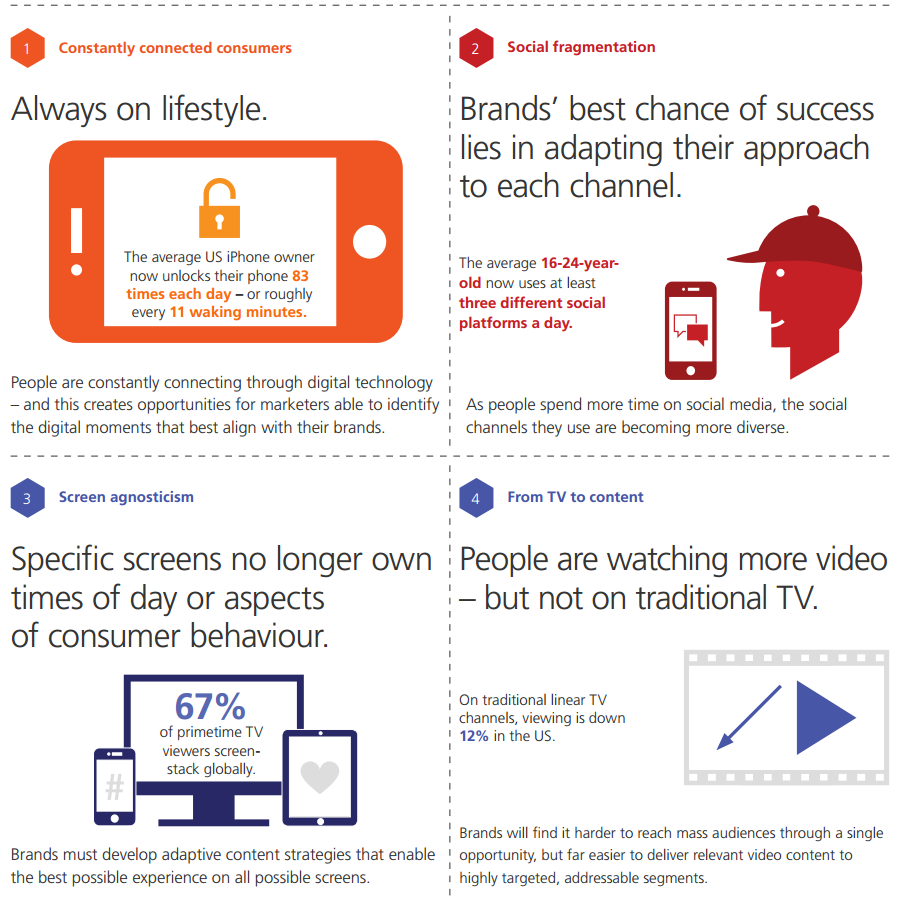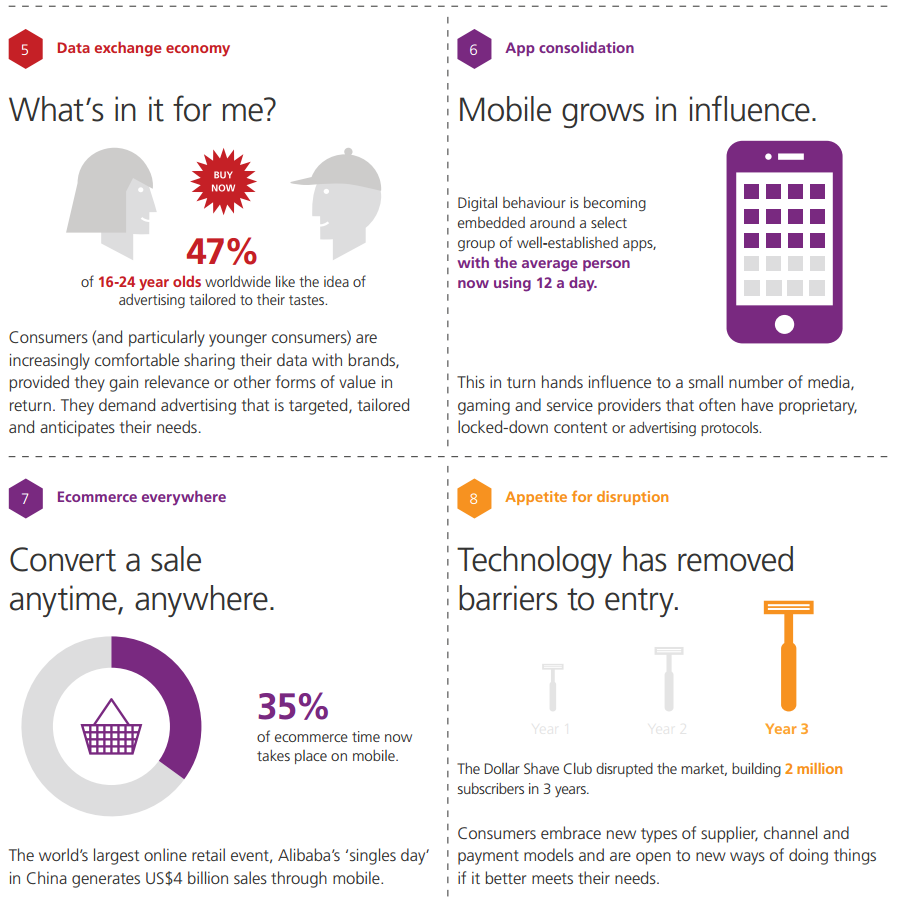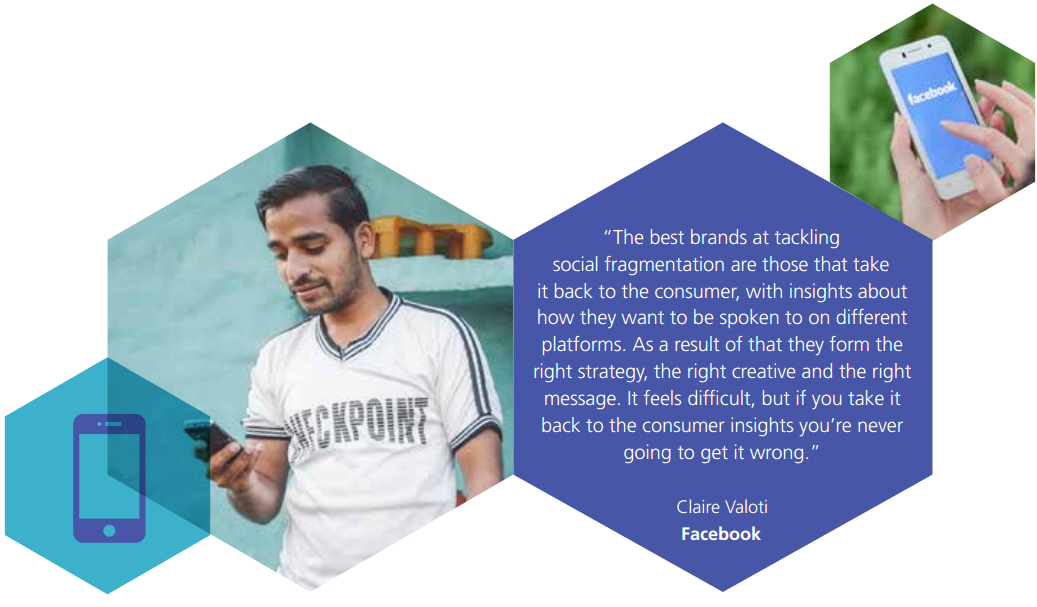 The dynamics of transforming consumer behaviour
The dynamics of transforming consumer behaviour
Fast-moving digital technology has driven almost continuous change in attitudes, behaviour and habits, and this has been hugely disruptive for marketing. However the technologies that set the parameters for connected consumer behaviour are no longer new.
The Apple iPhone turned eight this year, Facebook and Twitter have been part of the public consciousness for almost a decade, and LinkedIn and Google have been around for even longer. As the technology becomes more familiar, the trends in people’s behaviour have become more consistent and predictable:


 The five most important opportunities for marketers
The five most important opportunities for marketers
Marketing departments are not short of options when it comes to how they spend time and money trying to keep up with the new dynamics of consumer behaviour. But how can they prioritise their efforts to target the right opportunities?
There are five priority areas where brands should be focusing their efforts in order to maintain their strategic focus and use the technologies now available to strengthen their connection to consumers. All of these opportunities enlist new digital technologies for growth; and all of them demand change in how brands develop and deliver their strategy, and monitor and improve performance.

Opportunity 1
Fuse data and strategy in targeting
The way people choose brands and products is complex, involving emotional and functional needs, the promptings of affective memories 1 , habit and other forms of unconscious behaviour, as well as their conscious attitudes. Because of this, not all consumers are created equal when it comes to brand strategies; it is vital to target those that are actually open to spending more with you.
Over the past 50 years, consumer segmentation studies have advanced to the point where most brands have a clear and robust understanding of whom they should be targeting and why. And nothing in the new, digitally shaped consumer landscape changes the fact that targeting the right people is the key to growth. In fact the data exchange economy and the willingness of people to share personal information in exchange for more relevant brand interactions provides many more opportunities to do so. The problem is, that’s not how many brands are using the data available to them.

Programmatic technology and data-driven targeting provide huge opportunity for marketers. However brands often pass up that potential by focusing solely on behaviour-driven targeting. By prioritising consumers who are exhibiting buying behaviour, they tend to focus too much attention on the bottom of the funnel, paying to serve too many ads to people who are already well-advanced in their buying decisions (and whom other brands in their category are bombarding to saturation point as well). Indeed, if the behaviours being targeted are more than a few days old, the chances are the consumer in question has already made a purchase and is no longer in the market. Programmatic is not a one-trick pony. It has a far bigger strategic and brandbuilding contribution to make.
The real opportunity lies in integrating strategy-driven segmentation with Data Management Platforms (DMPs) to target precisely the right people at scale, much earlier in the brand funnel. The good news is that this is already possible – and its impact on effectiveness is huge. When one TNS client, a major hotel group, adopted a strategy driven approach to targeting consumers through DMPs, it increased site bookings more than five-fold compared to other targeting methods. The most successful brands in the new, connected landscape are those that start with strategy and focus on using data to activate it.
1 Affective Memory measures the long term brand-building potential of advertising – covering the three dimensions of Novelty, Affective Impact and Relevance – which show whether the campaign will be noticed and brand associations assimilated into long term memory.
Opportunity 2
Customise for consumer and context
Brands are realising that the promise of participatory campaigns has been overhyped. Consumers aren’t going to interact with your brand just because you ask them to. As has always been the case, content is king. The most effective advertising and content aligns with the values, motivations and priorities of its target audience.
This becomes far easier to achieve when you have the opportunity to customise your approach for each segment that you target, and for each context that you target them in. However despite the capability that marketers now have to reach addressable audiences across different channels, remarkably few take the opportunity to adapt their creative. Less than 10% of digital advertising campaigns tailor content to different audiences (distinguishing between men and women, for example).
This is all the more surprising given the obvious benefits of customising creative. There’s little point running a TV ad on YouTube if it doesn’t get over its key messages in the first 5 seconds, after which many users will skip it. People using Snapchat expect a very different tone of voice from brands than those using Instagram. Marketers must adapt to the social nature of digital interactions, demonstrating quickly and clearly that they have a contribution to make, and that they understand the conversation they are asking to join.
Part of the problem lies in budget allocation. Many brands continue to devote large slices of spend to producing and running TV campaigns, whilst allowing very little for adapting content to different platforms. Rebalancing these priorities can dramatically increase effectiveness. It can also open the way for cutting-edge content partnerships with apps and other media players, which can align a brand with the user experience.

Opportunity 3
Target moments not media channels
Once upon a time, people tended to use particular media platforms for particular purposes, and often at particular times of the day. And much of campaign planning tended to revolve around these well-understood rhythms. The evolution from broadcast TV to personalised video content schedules has transformed this.
People’s use of digital platforms is increasingly driven by habit and compulsion. It is triggered by different aspects of their daily routine, or by particular situations and environments that occur less frequently but result in predictable digital behaviour nonetheless. Some scenarios automatically trigger people to check their email; others to see if the headlines have changed on their favoured news site; others to check a weather app. The key to targeting these moments effectively and imaginatively lies in identifying which best align with a brand’s objectives.
 For some brands, whose ability to sell is enhanced in particular situations or times of day, these objectives will revolve around sales. For others, it’s a case of identifying when consumers are most likely to be thinking about their brand – and when they are most open to communication from it. Social media listening helps map out the moments when a brand can most effectively align itself with its audience’s agenda: when a tweet is most likely to be retweeted, a Facebook video most likely to be commented on, or a LinkedIn update most likely to be shared.
For some brands, whose ability to sell is enhanced in particular situations or times of day, these objectives will revolve around sales. For others, it’s a case of identifying when consumers are most likely to be thinking about their brand – and when they are most open to communication from it. Social media listening helps map out the moments when a brand can most effectively align itself with its audience’s agenda: when a tweet is most likely to be retweeted, a Facebook video most likely to be commented on, or a LinkedIn update most likely to be shared.
We all know about famous real-time marketing that responds to spontaneous, shared moments as they develop (in the style of Oreo’s Superbowl tweet). However, the most powerful opportunities for brands often lie in the moments that are repeated on a regular basis, and which don’t need traditional TV coverage to help create them. Axe’s alarm clock campaign in Japan, which featured a cheekily flirtatious alarm call message, and dramatically increased the brand’s repurchase rate, is a simple example of how effective targeting moments can be.
Opportunities for moment-based targeting are rapidly expanding as platforms such as Twitter and Google roll out time-specific ads designed to address specific moments in the day. To make the most of these opportunities, brands need to invest in understanding the moments that matter most and how they can best target them.
Opportunity 4
Master multi-modal touchpoints
A well-known airline once structured its management of social media platforms so that responsibility for Twitter sat squarely with its digital marketing team. This seemed logical enough, until the team members found themselves making regular sprints down to the customer service department whenever a passenger tweeted about problems with their travel plans. It’s a vivid example of how brands can no longer predict which touchpoints consumers will use for which purposes.
In fact, research shows that a growing proportion of younger connected consumers want to use a favoured social platform such as Twitter for every aspect of their interaction with a brand, including buying from it.
Traditional views of a ‘purchase funnel’ are becoming increasingly outdated as a result. Marketers who focus on moving consumers from platform to platform until they reach a predetermined conversion point risk frustrating their audiences and missing out on sales.
In an era of screen agnosticism and ecommerce everywhere, people may want to convert at any moment, on any channel, and it’s important to help them do so.  This involves taking an innovative approach to the potential of each touchpoint, optimising them all for conversion, and then evaluating how they perform. Air New Zealand excels at using Twitter for customer service, brand building and sales simultaneously. Mondelez has turned online banner ads into conversion opportunities through its ‘buy now’ buttons. Meanwhile the Apple Store has an obvious role as a retail outlet, but it’s also a brand experience centre, a content distribution channel, and a customer service delivery point. These brands understand the importance of exploring the full range of roles that each touchpoint can play.
This involves taking an innovative approach to the potential of each touchpoint, optimising them all for conversion, and then evaluating how they perform. Air New Zealand excels at using Twitter for customer service, brand building and sales simultaneously. Mondelez has turned online banner ads into conversion opportunities through its ‘buy now’ buttons. Meanwhile the Apple Store has an obvious role as a retail outlet, but it’s also a brand experience centre, a content distribution channel, and a customer service delivery point. These brands understand the importance of exploring the full range of roles that each touchpoint can play.
Opportunity 5
Keep searching for the direct route
Consumers are more open to new business models and new types of supplier than ever before. Over the last decade, digital technology has helped remove barriers to entry across categories, and rewritten rules about where a given brand has permission to play. Disruption has become the norm – and it is expected to deliver ever-improving consumer experiences.
Often, although not inevitably, these improved consumer experiences are delivered through shortened or service-based delivery models. Reinventing supply chains and distribution strategies enables solutions that are focused far more clearly on consumer needs. This has been key to the success of Dollar Shave Club’s ‘blades-as-a-service’ strategy, and Amazon’s Dash system for restocking kitchen cupboards. And by connecting consumers directly to potential suppliers and bypassing established processes, associations and regulations, it has also provided the foundation for Uber and Airbnb.
 Brands must respond on a strategic level by building the consumer appetite for disruption into their planning. This will involve broadening the scope of innovation beyond the next iteration of existing products; instead, businesses must be prepared to challenge and reshape the way that distribution models work – and consumers buy. As businesses like Kodak and Blockbuster discovered long ago, business models can rapidly become obsolete if a more consumer-centric proposition comes along.
Brands must respond on a strategic level by building the consumer appetite for disruption into their planning. This will involve broadening the scope of innovation beyond the next iteration of existing products; instead, businesses must be prepared to challenge and reshape the way that distribution models work – and consumers buy. As businesses like Kodak and Blockbuster discovered long ago, business models can rapidly become obsolete if a more consumer-centric proposition comes along.
In seeking new opportunities to meet consumer needs, brands must be prepared to explore opportunities beyond their core category where relevant – and update their understanding of brand stretch to reflect new consumer expectations. When technology companies such as Google can launch new categories of vehicle, and social networks can compete as payment providers, category boundaries are no longer what they were. However, success still depends on identifying unmet needs and understanding the strengths and weaknesses that a brand has when it comes to meeting them.
In an increasingly connected world, disruptive innovation rarely occurs in a vacuum. The nimblest and most successful innovators are those that can identify when changes in the technological ecosystem surrounding them enable new forms of delivery that meet consumer needs more ideally. And they are able to move quickly to own the opportunity space that results.
Conclusion
Mastering the perpetual marketing cycle
 The new digital landscape demands an ‘always-on’ approach to marketing, where performance is evaluated and improved continually. Many marketers are already making this transition. However, they must be careful that the principles of brand strategy don’t get left behind. Always-on doesn’t mean racing to respond to every niche consumer trend or technology-driven opportunity just because it’s there.
The new digital landscape demands an ‘always-on’ approach to marketing, where performance is evaluated and improved continually. Many marketers are already making this transition. However, they must be careful that the principles of brand strategy don’t get left behind. Always-on doesn’t mean racing to respond to every niche consumer trend or technology-driven opportunity just because it’s there.
We may no longer have the time and space to analyse results from one campaign before planning the next one – but this isn’t a reason for abandoning the link between strategy, activation and performance. Instead we need to build better models for integrating the three.
This will involve new approaches to media planning and buying that enable more responsive and adaptable advertising; it will involve new types of brand content partnerships that are not limited by channel; it will involve models that can turn data rapidly into precise, actionable insight; and it will involve a commitment to continuous innovation. Above all though, it requires a deeper and a more nimble understanding of the consumers that are driving the change.
Get in touch
If you would like to talk to us about anything you have read in this report, please get in touch via:
Jonathan Sinton
Digital Director, TNS









